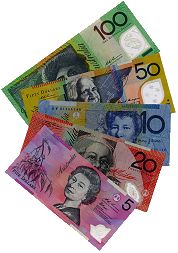Detailed chart analysis of past trading action
Identified where reversion and break-out trading occurred
The image below is the chart of Australian Dollar futures contract ( CME Ticker Symbol: 6A ).
It is a multi-days chart showing Composite Time Price Opportunity (TPO) Profile on the left side
and Composite Volume Profile on the right side.
This is an unique charting technique and requires some explanation on how to read the chart.
This chart shows more information than the conventional graphical chart. Don't be overwhelm.
Once you get accustomed to reading this type of chart, it will stimulate your whole brain. The
left hemisphere of your brain which is responsible for logical, rational and analytical functions will
be engaged by the numerical data portion of the chart. The right hemisphere of your brain which
is responsible for the intuitive and subjective functions will be engaged by the graphical portion of
the chart.
This gives you an advantage of engaging your whole mind when it comes to trading instead of using
just a section of it.
Showing
Time Price Opportunity (TPO)
Profile side-by-side to Volume Profile gives you a quick synopsis of
- which price levels received the most trading volume
- at what time during the trading session had it traded there
- how many times it had backfilled to those price levels
- where reversion trades worked for traders fading the move as price traded back and forth to form a cluster node
- see where and when break-out trades occurred as price spends very little time trading there
(Click on image below to bring up thumbnail and enlarge the chart.)

Legends:
- VAH = Value Area High
- VAL = Value Area Low
- POC = Point of Control (i.e. where most of the trading volume had occurred)
- TPO Count = Where trading has spent the most time
- VWAP = Volume-Weighted Average Price
- BOO = Break-out Octet. Minimum stop loss risk on false break-outs
- BDO = Break-down Octet. Minimum stop loss risk on false break-downs
- Each TPO letter represents half hour intervals
- TPO { abcdefghijklmnop } are the Asian Session
- TPO { qrst } are when both Asian and European Traders are awake, alert and online
- TPO { uvwx } are the remaining European Session
- TPO { yzVWXYZABCDE } are when both European and American Traders are awake, alert and online
- TPO { FGHIJKLMNOPQ } are the remaining American Session
Country Profile and Fundamental Analysis
Australia is the sixth largest country in the world. It is an English-speaking country. Australia
is made up of six states and two territories: New South Wales, Queensland, South Australia, Tasmania, Victoria,
Western Australia, the Northern Territory, and the Australian Capital Territory. Australia is a popular tourist
destination. It has a nice warm climate and many beautiful beaches.
Australia’s largest export markets are Japan, China, the United States, Republic of Korea and New Zealand.
The ports of Sydney and Melbourne on the east coast of Australia are the major trading centers for manufactured
goods. Natural resources and commodities such as wheat are shipped from major facilities around the nation’s
coast line.

Australia has abundant natural resources and exports coal, lead, nickel, copper, manganese ore, Liquefied
natural gas (LNG), iron ore, silver, diamonds and gold.
Australia has a free market economy and a stable government. They have a high GDP per capita and
low rate of poverty. The interest rates offered by Australian Banks to their depositors are very
attractive. A one year term deposit bank account is returning roughly 6.00% interest. This is high in
comparison to United States banks which are around 0.75% interest rates.
The time zone difference between Australia and the United States offers an opportunity for Americans to dabble
in the forex market after work. When it is early evening in the United States, it is the beginning of the day
in Australia. Americans can trade after work from their homes when Australians are starting their day
in the office.
In addition to trading the Australian Dollar in the forex market, any excess idle cash holdings of the Australian
Dollar can be put to use for trading Australian stocks. The Australian Securities Exchange (ASX) is open from
10am to 4pm Sydney time.

|
